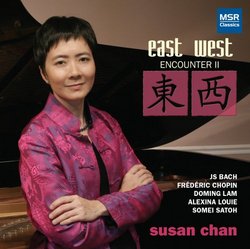| All Artists: Susan Chan Title: East West Encounter II - Works for Solo Piano Members Wishing: 2 Total Copies: 0 Label: MSR Classics Original Release Date: 1/1/2009 Re-Release Date: 10/28/2008 Genres: New Age, Classical Styles: Instrumental, Opera & Classical Vocal, Chamber Music, Historical Periods, Classical (c.1770-1830) Number of Discs: 1 SwapaCD Credits: 1 UPC: 681585128022 |
Search - Susan Chan :: East West Encounter II - Works for Solo Piano
 | Susan Chan East West Encounter II - Works for Solo Piano Genres: New Age, Classical
Doming Lam was born in Macau, received his musical education in California and Toronto, and has been spending a large part of his career in Hong Kong. In this piece, Lam uses a popular ancient melody with the original name... more » |
Larger Image |
CD Details
Synopsis
Product Description
Doming Lam was born in Macau, received his musical education in California and Toronto, and has been spending a large part of his career in Hong Kong. In this piece, Lam uses a popular ancient melody with the original name of The Flutes and Drums at Sunset, The Pipa of Shin-Yang, or Moonlight at Shin-Yang. He selected six out of the original ten sections of the melody and wrote them in the form of variations in 1971. Through this piece the composer expresses his hope that the younger Chinese generation would enjoy and perform Chinese music as well as disseminate the best of Chinese music overseas. This traditional sounding piece imitates on the piano the sound qualities of the Chinese chin (zither) and pipa. Japanese composer Somei Satoh enjoys a fine international reputation, especially in the United States, where several of his pieces have been premiered and performed. Satoh, who came from a musical family and attended Nihon University in Tokyo, was mostly self-taught, and is very interested in the prolongation of a single unit of sound through repetition. A very unconventional piece, Incarnation II is made up entirely of tremolos in the lower range of the piano. The music seems to come from nowhere, develops through a gradual and stepwise sliding motion of notes from one chord to the next, reaches two climaxes, and subsides back into nothingness. This piece shows the deep influence of Shintoism and Zen Buddhism, and seems to take the audience on a journey of meditation. Memories in an Ancient Garden and Warrior are two of three pieces in Chinese Canadian composer Alexina Louie s Scenes from a Jade Terrace, commissioned and premiered by Canadian pianist Jon Kimura Parker. The haunting Memories explores the coloristic possibilities of the piano by using glissandi and harmonics on the strings as well as palm clusters on the keys. The work is striking in its colors as well as its fusion of Eastern and Western philosophy and musical language. Varied temporal organization and Oriental-sounding scales, harmonies and textures result in a rich symphonic poem expressed through the piano. Prelude in B minor was transcribed by Alexander Siloti from a short E minor Prelude in Johann Sebastian Bach s Clavier-Büchlein für Wilhelm Friedemann Bach, written for the instruction of his oldest and possibly favorite son. Reminiscent of the Prelude No.1 in C major from The Well-Tempered Clavier I, the music progresses gradually in the form of broken chords. The hidden melody in the middle of the texture is brought out in the repeat. Sheep May Safely Graze was originally an aria for soprano in Cantata No. 208, entitled Hunting Cantata or Birthday Cantata, which Bach composed for the birthday of Duke Christian of Saxe-Weissenfels in 1713. The serene and pastoral character of the music is well preserved in Egon Petri s transcription and reflects the text of this aria: Sheep may safely graze where a caring shepherd guards them. Where rulers govern well, we may feel peace and tranquility, and the country will prosper. Jesu, Joy of Man s Desiring is the title of a chorale movement from Bach s Cantata No.147, entitled Heart and Mouth and Deed and Life, written in 1716. As in the original chorale, the passage with triplet figures and the choral passages are first presented in alternating fashion, after which they are interwoven in the texture and build steadily to a climax toward the end of the piece. In this transcription by Kempff, the melody is ingeniously stated in the tenor and alto ranges as the piece unfolds. Published in 1839, the set of Twenty-Four Preludes, Op.28, was mostly composed from 1837 to 1838, when Chopin and George Sand were staying in Majorca and were in the earlier stages of their tumultuous relationship.

 Track Listings (18) - Disc #1
Track Listings (18) - Disc #1